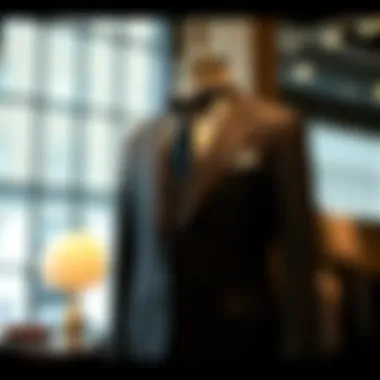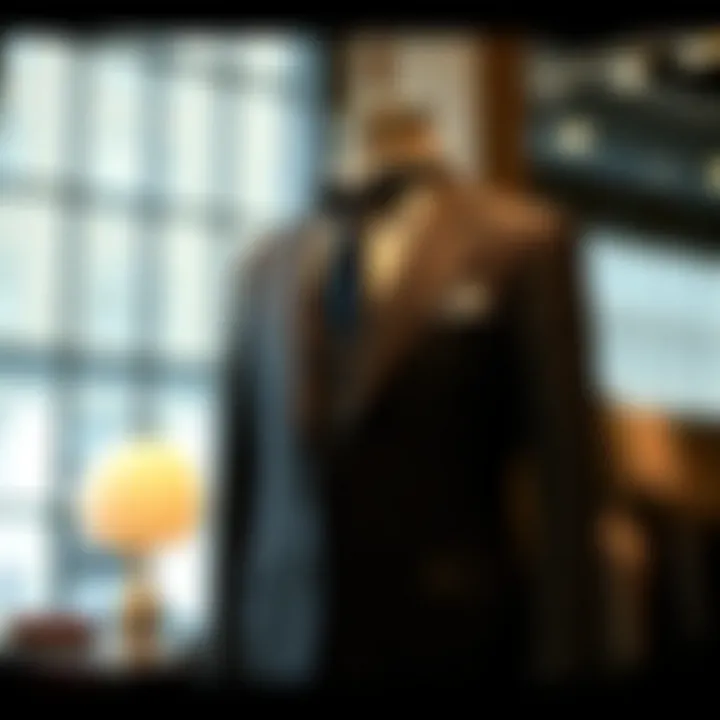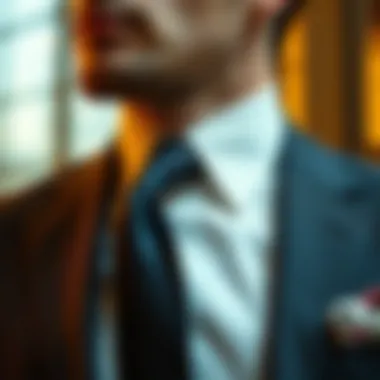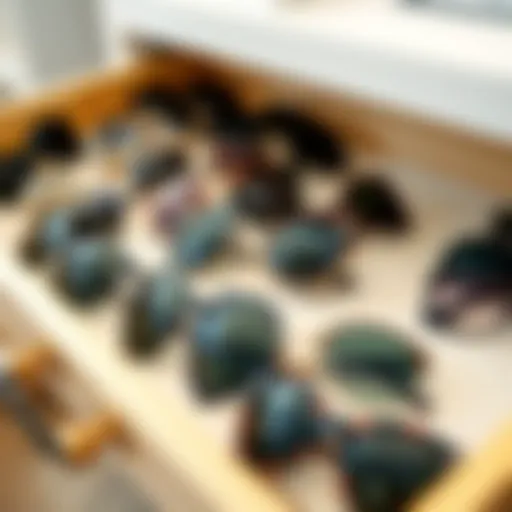The Allure of Men's Suits: Style and Sophistication


Intro
Diving deep into the world of men's suits is akin to unearthing a treasure trove of culture, style, and masculinity. Suits are more than just pieces of fabric stitched together; they carry a legacy that transcends time. The allure of men's suits lies in their ability to transform appearances, evoke confidence, and create an air of sophistication that is hard to replicate. Whether it's the tailored cut for a business meeting or the vibrant fabric for a wedding, suits encapsulate versatility and elegance.
From the meticulous selection of fabrics to the subtle nuances of fit and color, every element plays a pivotal role in curating a perfect ensemble. As one explores the rich history and development of men’s suiting, it becomes clear how these garments reflect societal norms and personal style choices that have evolved alongside changing fashion trends.
This article aims to provide a thorough examination of various aspects related to men’s suits – from how styles have morphed over the decades to understanding the importance of fabric types, complementary colors, and accessories. Moreover, it touches upon the current sustainable practices that influence modern fashion, ensuring that today’s wardrobe not only looks good but is also ethically constructed.
The allure of suits is not merely a fleeting trend; it's an ever-present pillar in the world of men's fashion that continually adapts to meet the demands of contemporary society. Join us as we explore the intricate tapestry of men's suits, unraveling their history and injecting a touch of personal flair for the modern gentleman.
The Historical Context of Men's Suits
Understanding the historical context of men's suits lays the foundation for appreciating their enduring charm and sophistication. Suits are more than mere clothing; they represent a tradition steeped in social status, elegance, and functionality throughout the centuries. By dissecting their development, we can draw parallels to contemporary fashion and niche styles that continue to influence modern wardrobes. Several key points emerge when examining this period, revealing both the transformation of suits and their cultural significance over time.
Origins in Nobility
Suits trace their origins back to the wardrobes of the elite. The 17th century set the stage for what would evolve into the contemporary suit, primarily among the European nobility. Back then, clothing was a magnificent display of wealth and power. Fat, ornate jackets combined with lavish fabrics were the norm. The nobility were often seen in richly embroidered coats, complemented by waistcoats and breeches, which not only clothes their bodies but also sent a clear message of status. These styles provided a reference for the simpler, yet refined silhouettes of today's suits.
Despite their opulence, these early designs began to shift in response to societal changes. The aristocracy gradually lost its dominance, leading the way for a more democratized approach to fashion. Tailoring became more accessible, as the bourgeois class began adopting and adapting court styles, contributing to the development of the structured suit we know today.
The Evolution Through the Ages
By the 19th century, the concept of what a suit looked like was rapidly evolving. The industrial revolution ushered in changes not only in textiles but also in the manufacturing processes that produced menswear. Tailoring became a blend of artistry and practicality, with both personal fit and broader styles that catered to varying tastes.
- The morning coat emerged, favoring practicality for middle-class men of leisure.
- The three-piece suit, consisting of jacket, trousers, and waistcoat, debuted, reflecting a more contemporary, polished look.
During the early 20th century, the design of suits continued to innovate, influenced by events like the World Wars that brought about fabric shortages. Styles became more utilitarian, resulting in the streamlined, no-nonsense suits suited for men at work. The post-war era saw a resurgence of luxury and confidence in menswear, leading to the iconic "power suits" of the 1980s characterized by bold colors and oversized silhouettes.
Cultural Influences on Suits
Suits have always been swayed by broader cultural movements. From the roaring twenties’ jazz age to today’s casual Friday, societal norms have shaped how men approach formal wear. The incorporation of tailored suits into media, especially film and television, played a significant role in elevating their status. Think of James Bond’s impeccable tuxedos or the tailored ensembles of iconic figures like Steve Jobs and Barack Obama.
Different cultures have contributed various elements to the suit. Italian tailors are renowned for their luxurious fabrics and vibrant colors, while British styles often lean towards the classic and structured. In the 21st century, sustainability has transformed the landscape of suits, with designers turning to eco-friendly materials and ethical production practices.
"Fashion can serve as a powerful mirror reflecting the era's values, aspirations, and complexities."
In sum, the historical context of men's suits reveals a narrative that intertwines with social dynamics, craftsmanship, and cultural shifts. As style continues to evolve, understanding this backdrop provides invaluable insights into modern trends and the enduring appeal of suits.
Understanding Suit Styles
The realm of men's suits extends far beyond mere fabric and stitching; it encapsulates an entire universe of style, identity, and cultural significance. Understanding suit styles is pivotal as it allows individuals to express themselves through the myriad of choices available. This section delves into various suit styles, each resonating with its own history and customary norms, providing insights into how these styles can adapt to different occasions. Understanding the diverse cuts, shapes, and modern trends not only enriches one's wardrobe but also enhances confidence and presence in varied settings.
Classic Cuts and Their Significance
Classic suit cuts have stood the test of time, firmly embedded in the fabric of menswear history. The notched lapel, double-breasted, and single-breasted suit types represent enduring styles often associated with formality and sophistication. These suits often tell a story of their wearers—where one might opt for the traditional elegance of a single-breasted suit for a business meeting or the bold confidence of a double-breasted ensemble for a social gathering, each style serves a purpose.
With a structured shoulder and a tapered waist, classic cuts enhance the male silhouette. It is not merely about the visual appeal either; it’s about how these styles convey authority and reliability. Suiting for events such as weddings or corporate events frequently calls upon these classic designs, underlining their relevance despite changing trends in fashion.
One might argue that classic cuts are the bread and butter of men's suiting. They can easily transition from day to night, making them a worthwhile investment. Furthermore, these styles lend themselves well to alterations, ensuring a personalized fit that can last for years. As the fashion cycle continues to evolve, the classic cuts remain a steadfast choice. It’s a hallmark of elegance that speaks for itself.
Modern Tailoring Trends
Moving into contemporary society, the realm of men's suits has seen an incredible transformation. Modern tailoring trends emphasize not only aesthetics but comfort as well. The lines between casual and formal have blurred, leading to innovative designs that cater to a more versatility. An example would be the slim-fit suit, which has gained traction among younger generations. It relies on sleek, clean lines that embrace a modern figure without sacrificing comfort or mobility.
Additionally, suits today often incorporate stretchy fabrics that allow for ease of movement, making them appropriate for various settings. Tailoring practices are also integrating more relaxed styles, akin to streetwear aesthetics. Expect to see softer shoulders, unstructured blazers, and cropped trousers that embrace a more playful take on traditional suits.
Among modern styles, the ‘athleisure suitÂ’ trend stands out. This concept merges leisurewear with formal attire, paving a way for suits that evoke an effortless look combined with comfort—a notable contrast to the formal rigidity of previous decades.
Thus, today’s suits aren’t just tailored; they are tailored to life, accommodating every twist and turn one encounters throughout the day, while still upholding that essence of sophistication.
Comparing Formal and Casual Suits
There exists a distinct divide between formal and casual suits, and understanding this can drastically influence personal style choices. Formal suits are characterized by their refined cuts and traditional fabrics, often selected for significant occasions such as weddings or high-profile meetings. These ensembles demand attention to details—accessories like ties or pocket squares are carefully curated to complement the overall appearance.
On the flip side, casual suits embrace a level of relaxed styling that encourages personalization and creativity. Fabrics such as cotton or linen dominate in this category, and styling can diverge significantly, inviting elements such as t-shirts or sneakers to the mix. A casual suit is not confined to the rigid codes of formal attire; it allows freedom of expression that reflects one’s personality.
Choosing between a formal or casual suit largely hinges on the occasion and the message one seeks to convey. Formal suits demand respect, while casual suits extend an invitation for self-expression embraced with confidence.
Fabric Choices: Finding the Right Material
The choice of fabric is paramount when selecting a suit. It is not just about how the suit looks, but also how it feels and performs in various conditions. A fabric's weight, texture, and breathability significantly influence comfort, durability, and overall style. With various options available, understanding these fabric choices helps in curating a sophisticated wardrobe that aligns with personal style and lifestyle needs.
Wool: The Timeless Choice
Wool has a long-standing reputation as the go-to fabric for men's suits. Its natural fibers provide a range of benefits that are hard to beat. For starters, wool is renowned for its resilience, allowing suits to maintain their shape and resist wrinkles. This characteristic makes it a smart choice for long days at work or events. Not to forget, wool has a natural ability to regulate temperature, keeping the wearer comfortable regardless of the climate. Whether it's a chilly office or a warm summer evening, wool adapts.
Moreover, wool comes in a variety of weaves, such as worsted and flannel, allowing for versatility in style and weight. For instance, worsted wool is commonly used for formal occasions, providing a sleek, polished look. On the other hand, flannel suits have a softer charm, perfect for catered events or less formal gatherings. The endless availability of colors and patterns in wool only adds to its allure.
Linen for Summer Elegance
When the temperature rises, linen becomes the fabric of choice. The lightweight and breathable nature of linen allows for comfort during the sticky summer months. Unlike wool, linen's loose weave facilitates airflow, giving the wearer an easygoing style while still looking sharp. It's ideal for outdoor weddings or tropical vacations where you don’t want to feel constricted by heavier fabrics.
However, linen does have its quirks. It wrinkles easily, which can be both a boon and a bane. Some folks embrace the relaxed, lived-in look of a wrinkled linen suit, considering it a sign of a laid-back attitude towards fashion. Others might want to keep it crisp and clean; this often requires frequent steaming or ironing. Nonetheless, the casual yet chic vibe that linen provides makes it an indispensable choice for warmer weather.
Blends and Synthetic Fabrics
Lastly, we see the rise of blends and synthetic fabrics in the suiting arena. Blends, often made from wool combined with polyester or elastic materials, offer durability at a lower price point. These are often more resistant to wrinkling and feature low maintenance needs, making them appealing for the everyday businessman. However, they may lack some of the breathable qualities that natural fibers offer.
Synthetic fabrics, such as microfiber and rayon, have their place as well. These materials are typically more affordable and can imitate the look and feel of more expensive fabrics. While some might question their overall quality, their resilience and ease of care make them popular. In particular, microfiber suits can often repel water and stains, which is a practical benefit for those in dynamic environments.


"The fabric of your suit can be a reflection of your personality, telling the world how you view style, sophistication, and comfort."
Understanding these fabric choices is crucial in navigating the world of men's suits. By considering the various attributes of wool, linen, and synthetic options, one can make an informed decision that enhances both function and style in their wardrobe.
Color Trends: Making a Statement
In the world of men’s suits, color plays a pivotal role in transforming a simple outfit into a statement of style and sophistication. Understanding current color trends not only showcases individuality but also reflects a deeper connection to cultural and social shifts. Beyond mere aesthetics, color serves as a tool for communication, allowing wearers to convey confidence, personality, and even professionalism.
The Power of Neutral Colors
Neutral colors remain the foundation of men’s suiting, revered for their versatility and elegance. Shades like black, gray, navy, and beige create a timeless palette that's far from boring. These colors have an innate ability to adapt to different settings—whether it's a corporate meeting or a casual gathering.
When considering neutral colors, one must appreciate how they enhance the wearer’s overall look without overpowering it. For instance, a well-tailored charcoal gray suit paired with a crisp white shirt can project authority in a boardroom meeting, while a simple navy suit can effortlessly transition to an evening event with a change of accessories.
- Benefits of Neutral Colors:
- Versatility: Easily paired with various shirts and ties.
- Timelessness: A neutral suit never goes out of style.
- Easy Maintenance: Less prone to looking wrinkled or stained.
These colors create a blank canvas, making it simple for individuals to express personal flair through accessories, such as ties or pocket squares. Moreover, their understated nature amplifies the impact of a confident stance, reflecting poise and certainty.
Bold Colors and Their Impact
In contrast to the subtlety of neutrals, bold hues can dramatically alter the perception of a suit wearer. Colors like burgundy, emerald green, or even electric blue can inject life into a traditional arrangement, making an undeniable statement.
When choosing bold colors, one must tread carefully. The key is understanding how these shades align with one’s skin tone and personal style. For example, a deep burgundy suit might suit someone with warmer undertones, instantly bringing warmth and vibrancy to their overall appearance.
- Considerations for Bold Colors:
- Occasion appropriateness: Suit up boldly for evening events; reserve more conservative colors for professional settings.
- Coordination: Ensure your accessories complement the bold hue.
- Confidence: Wearing striking colors demands self-assuredness; embrace it to leave a lasting impression.
Bold colors allow for personal expression and can communicate creativity and courage, celebrating individuality in the often-conservative world of menswear.
Patterns: Stripes and Checks
Patterns in suits, particularly stripes and checks, can add an exciting dimension to traditional suiting. A pinstripe suit can convey professionalism, while checks offer a casual twist without sacrificing elegance.
Each pattern comes with its own nuances: pinstripes elongate the silhouette, making them a popular choice for taller individuals aiming for a sophisticated profile. Meanwhile, checks, like houndstooth or gingham, may bring a sense of playfulness, ideal for social gatherings or fewer formal events.
- Characteristics of Patterns:
- Stripes: Often favored in professional settings; they can create an illusion of height.
- Checks: Great for a relaxed, stylish vibe; they come in various sizes and colors.
When donning a patterned suit, it's essential to balance it with solid color shirts and ties to avoid a chaotic look. Different patterns can merge with one another, offering a unique opportunity to showcase distinctive ability to mix and match while maintaining an air of sophistication.
Understanding color trends is not merely about fashion; it’s about making deliberate choices that resonate with who you are. Whether choosing a classic neutral or a bold statement, each color reflects a piece of your story in the sartorial narrative.
In summary, color trends in men’s suits extend beyond visual appeal, digging deeper into the modern identity of style. By carefully selecting shades and patterns, anyone can assert themselves in any setting, ensuring their attire speaks volumes about their sophisticated taste.
Sizing and Fit: Achieving the Perfect Silhouette
When it comes to men’s suits, size and fit are paramount. If a suit doesn’t sit well on the body, even the finest fabric or the most expensive designer label will not save it from looking unkempt. Achieving the right silhouette is about more than just size; it’s about enhancing one's physique and projecting an image of confidence and sophistication.
Understanding Tailoring Basics
Tailoring is an art form that directly influences how a suit looks and feels on the wearer. A well-tailored suit can cleverly hide imperfections while accentuating the wearer’s best features. The basics of tailoring involve elements like shoulder alignment, the tapering of sleeves, and the fall of the jacket. The importance of a tailor’s touch cannot be overstated; these professionals have a keen eye for detail and an understanding of how fabric drapes and shapes around the body.
A few essential points to note include:
- Shoulder Structure: The shoulders of the suit should align perfectly with the wearer’s shoulders. Too tight and it will pull; too loose, and it hangs awkwardly.
- Sleeve Length: Ideally, they should expose a quarter to half of the shirt cuff. When sleeves are fitting properly, the result is a streamlined appearance.
- Jacket Length: A jacket should cover the seat of the trousers, striking a balance that doesn't veer too casual or overly formal.
A tailor’s ability to navigate these critical areas can transform a basic suit into a bespoke masterpiece.
Different Fit Styles Explored
In the world of men’s suits, various fit styles cater to different body types and personal preferences. Understanding these options can lead to satisfactory choices when shopping for suits. Here are the common fit styles every man should consider:
- Classic Fit: This is a traditional fit that provides the most room, suitable for those who prioritize comfort. This style tends to have a more relaxed silhouette and is ideal for a timeless look.
- Slim Fit: A more modern cut, the slim fit contours closer to the body. It’s perfect for those who desire a sharp and sophisticated appearance without being overly tight.
- Tailored Fit: This style strikes a balance between classic and slim. It accommodates the contours of the body while ensuring it doesn't appear baggy or overly snug.
- Athletic Fit: Designed for men with muscular frames, it offers more space at the shoulders and chest, tapering down towards the waist for a fitted look.
Each fit serves a unique purpose and addresses various shapes and sizes, making it important to try on styles until you find the one that resonates best with your physique and style.
The Role of Personal Measurements
Knowing your own measurements is crucial when investing in a suit. Measurements can vary significantly depending on the manufacturer and the cut of the garment. Here’s how to ensure you have the right numbers:
- Chest Measurement: Wrap the measuring tape around the fullest part of your chest, ensuring a snug fit without constriction.
- Waist Measurement: Measure around the narrowest part of the waist, typically just above the belly button. This will guide the fit of your trousers.
- Inseam Measurement: Measuring from the top of the inner thigh to the ankle provides the perfect length for pants.
"Your own measurements act as the foundation upon which a perfect suit is built. Neglecting them is like trying to fit a square peg in a round hole."
By knowing these crucial measurements, you equip your tailor with the information needed to create a suit that truly fits like a glove. Small adjustments can make a world of difference, ensuring that your suit doesn’t just fit—you feel empowered wearing it.
Accessorizing Your Suit
Accessorizing a suit is more than simply throwing on a few items; it's about creating a visual appeal that complements the suit's style and enhances the overall look. Accessories serve as the finishing touch, conveying personal style while allowing room for creativity in an otherwise structured outfit. In this section, we’ll delve into the various elements of suit accessorization, exploring how they can transform a standard ensemble into a statement of elegance and individuality.
Ties and Bowties: Classic vs. Contemporary
Ties and bowties have long been staples in men's formalwear, each carrying its own historical connotation and aesthetic value. Ties are often seen as the more traditional choice, prevalent in corporate settings and formal events. They come in various patterns and materials, allowing for a wide range of expression. Classic silk ties offer a timeless elegance, whereas knitted ties provide a more relaxed vibe appropriate for smart casual settings.
On the other hand, bowties exude a sense of whimsy and sophistication, making them particularly popular at weddings or gala events. Recently, we’ve seen an uptick in contemporary adaptations of the bowtie, often made from unconventional fabrics like denim or featuring bold designs that challenge the status quo.


- Consider these factors:
- Occasion: A classic tie is more suitable for business meetings while a bowtie can shine at a cocktail party.
- Personal Style: Choose colors and patterns that speak to your personality but maintain harmony with the suit.
- Fit and Tie Style: Ensure the tie or bowtie properly complements the collar type of your shirt.
Choosing the Right Footwear
Footwear plays a crucial role in completing the suit look. Shoes can either elevate the sophistication level or detract from it, making the choice pivotal. Classic leather oxfords remain a popular choice for formal occasions, providing a polished and refined finish. When going for a more casual approach, loafers or derby shoes can strike a balance, lending ease while still looking sharp.
- Material Matters:
- Color Coordination:
- Style Syncing:
- Leather shoes, with their sleek appearance, are often favored. Alternatively, suede offers a softer, more relaxed look.
- Black shoes pair well with darker suits, while brown shoes can add dimension to lighter tones.
- The shoe style should resonate with the overall suit's vibe; a double monk strap might be better for a fashion-forward appearance compared to brogues.
Watches and Jewelry Considerations
When it comes to accessories, watches and jewelry elevate a suit's grandeur. A well-chosen watch stands as a mark of sophistication and style. Generally, minimalist designs tend to harmonize with suits better than chunky or overly elaborate timepieces. Remember that the metal of the watch should complement the color of the suit and the hardware of the other accessories.
Jewelry, like cufflinks or a lapel pin, can add a personal touch without overwhelming the outfit. Angular cufflinks in silver or gold can infuse a touch of elegance, while colored lapel pins might serve to pop the outfit and express individuality. The goal here is moderation; too much can easily veer into ostentatious territory.
"Accessorizing is about embodying your style while keeping the sophistication of the suit intact. Choose wisely!"
In embracing these accessory choices, one can achieve a well-rounded and sophisticated look that reflects individuality. From ties and shoes to watches and jewelry, every piece tells a story, elevating the suit from simple attire to a canvas for personal expression. Ultimately, it’s about balance; maintaining the suit's elegance while infusing personal flair remains key in accessorizing effectively.
The Role of Tailoring in Suit Making
Tailoring is not simply an afterthought in the world of men's suits; it forms the very backbone of suiting craftsmanship. A well-tailored suit does far more than just fit well; it embodies elegance, reflects character, and transforms the silhouette of the wearer. Understanding the role of tailoring is crucial for anyone passionate about the sartorial arts or looking to uplift their personal style.
Tailoring provides numerous benefits that go well beyond aesthetics. First, it ensures that the suit contours to the individual’s body shape, enhancing their physique. This creates a flattering appearance, which can convey confidence and authority. When suits are tailored properly, the result is a polished look that machine-made garments can seldom replicate.
Aside from aesthetic appeal, good tailoring promotes comfort. A well-cut jacket allows for freedom of movement without sacrificing style. Moreover, tailored suits can also incorporate personal touches, allowing the wearer to express individuality while adhering to established fashion norms. Tailors often consult with clients to include specific preferences, whether it be lapel styles, pocket designs, or even the placement of buttons.
In a world where fast fashion is prevalent, the art of tailoring stands out as a cherished, impactful craftsmanship. Consumers are increasingly aware of the ramifications of their purchasing decisions—this is where the importance of honing craftsmanship becomes clear, linking high-value tailored suits with quality and sustainability.
Handmade vs. Machine-Made
When it comes to suits, the choice between handmade and machine-made creates a significant divide. Handmade suits are often considered the pinnacle of luxury and craftsmanship. Every stitch, every cut is performed by skilled artisans who devote time and attention to detail. Such suits typically offer a bespoke experience, which means they are tailored specifically for the individual wearer.
On the flip side, machine-made suits provide convenience and affordability. These suits are mass-produced, allowing them to be available at a lower price point. However, they usually lack the personal fit and unique details that come with bespoke tailoring. This does not mean that machine-made options are inferior, as they can still offer good quality and a handsome appearance. It simply depends on what the individual values more: uniqueness or convenience.
In short, choosing between handmade and machine-made is primarily about priorities. Those with a penchant for exclusivity may prefer to invest in a tailor-made suit, while others looking for practicality might find capable, but affordable options in machine-made garments.
What to Expect from a Tailor
Walking into a tailor's shop for the first time can be an overwhelming experience, especially for those unfamiliar with the process. However, knowing what to expect can make the journey smoother. At the outset, tailors will usually conduct a thorough assessment, taking precise measurements and evaluating the client's body shape.
Expect to engage in a dialogue about style preference. The tailor may inquire about occasions for the suit, personal style likes or dislikes, and fabric choices. This helps ensure that the final product aligns with the individual’s vision. A good tailor also provides advice, weighing in on current trends and what would best suit the client's needs.
It's also important to be patient. A tailored suit does not simply emerge overnight; it usually involves multiple fittings. During these fittings, adjustments are made to ensure the perfect fit, which may include tweaking sleeve lengths or altering the taper of the trousers.
After the final fitting, the thrill of wearing a perfect suit—one that feels just as good as it looks—is unmatched. This experience highlights the journey from concept to creation, making every tailored suit a unique story.
The Cost of Tailored Suits
Discussing the cost of tailored suits can elicit a broad spectrum of reactions. Tailored options certainly come with a price tag that can seem steep at first. The range typically varies, influenced by the fabric selected, the tailor’s reputation, and the level of customization.
Generally, handmade suits can start in the lower thousands, whereas exclusive designers may price their bespoke offerings well above the average. However, many would argue that this investment is worthwhile given the longevity and timelessness a tailored suit provides. Unlike fast fashion, which tends to deteriorate after a few wears, a well-crafted tailored suit can last for years, even decades, when properly maintained.
For those with more constrained budgets, an option would be to seek out semi-bespoke services. These typically offer a balance between cost and quality, allowing for some level of customization while remaining more affordable than fully bespoke suits.
Suit Maintenance: Caring for Your Investment
Maintaining a men's suit is much more than simply hanging it up after wearing. It's a vital part of ensuring that your investment in style remains intact over time. Men's suits can be a significant financial commitment, and understanding how to care for them can enhance their lifespan and preserve their elegance. To keep that tailored look fresh, there are key elements to consider in your suit maintenance routine.
Cleaning Options Explained
When it comes to cleaning, one must tread with caution. Suits aren’t like regular clothes; they come with different materials, linings, and construction methods, each requiring personalized attention. Here’s a breakdown of common cleaning methods:
- Dry Cleaning: This is the most common approach for suit maintenance. It’s effective for removing stains without damaging the fabric. However, it should be used sparingly, as frequent dry cleaning can degrade the fabric over time.
- Spot Cleaning: If you notice a small spot, a gentle spot cleaning with a damp cloth can often work wonders. Instead of tossing the whole suit in for dry cleaning, treating small mishaps right away helps keep your suit in top shape.
- Steam Cleaning: Suits can benefit greatly from the occasional steam. Steam helps remove wrinkles and can refresh the fabric without the need for chemicals. Just be cautious and keep the steamer at a distance to avoid water spots.
"Treat a suit like a fine wine. Too much cleaning might spoil it; just the right touch brings out its best!"
Proper Storage Techniques
How you store your suit can significantly impact its longevity. Hang it properly and you’ll be extending its life rather than letting it sag and lose its shape. Here are some storage tips:
- Use the Right Hangers: Opt for broad-shoulder hangers made of wood instead of thin plastic ones. This helps in maintaining the shoulder structure of the suit.
- Dust Covers: When storing your suit in the closet, use a breathable garment bag. This protects it from dust while still allowing the fabric to breathe and avoid mildew.
- Avoid Overcrowding: Don’t jam too many garments in the closet. Crowding can lead to creases and almost ensures a wrinkled suit by the time you reach for it again.
Repairing Suit Damage
Even the best suits aren’t impervious to wear and tear. Whether due to a scuff, snag, or a loose thread, knowing how to address damage can save you a big headache (and potentially a big expense). Here’s what to do:
- Stay Prepared: Having a basic sewing kit handy can do wonders. A simple needle and thread can fix a loose button or a minor tear. Knowing some basic stitches can be very handy.
- Professional Help: For more significant damage or alterations, a tailor's expertise is invaluable. They can repair seams, address fabric issues, and make the necessary adjustments to ensure your suit continues to fit perfectly.
- Regular Maintenance Check: Incorporate routine checks into your suit care regimen. Inspect your suits for any signs of wear, especially after events where you might be particularly active. Immediately addressing these small issues can prevent larger problems down the road.
The consideration of maintenance details makes a significant difference to your suit, preserving its structure and aesthetic effectively. Making a habit of these practices will ensure that your investment not just holds its value but also continues to look sharp for years to come.
Suit Trends and Influences in Contemporary Fashion


The landscape of men’s fashion, especially concerning suits, is a dynamic one. Today’s trends are a fusion of tradition and innovation, reflecting shifting cultural norms and aesthetic values. Understanding these trends is essential for anyone wanting to make a mark in the world of fashion, as they often dictate consumer preferences and influence style choices across the board. As we plunge into this exploration, it’s important to grasp not just what’s trendy but why these elements resonate so powerfully with audiences.
Fashion Icons and Their Impact
When examining the influence of suits today, one cannot overlook the significant role fashion icons play. Figures like David Beckham or Timothée Chalamet have not merely worn suits; they've elevated them to an art form. Their choices reflect a blend of classic styles with daring modern twists.
- David Beckham often opts for tailored fits that emphasize his athletic physique, showcasing how a good suit can highlight one’s unique attributes.
- Timothée Chalamet, on the other hand, redefines the notion of formalwear by opting for vibrant colors and unconventional styles, urging younger generations to see suits as a canvas for personal expression rather than rigid attire prescribed by tradition.
These individuals serve as catalysts for change, proving that suits can be versatile and expressive rather than merely formal. People now seek suits that resonate with their personal style, pushing boundaries that were once firmly established.
Redefining Formal Wear
The definition of formal wear is undergoing a transformation, one that is both exciting and necessary. No longer confined to the four-cornered box of boardroom meetings and upscale weddings, suits now infiltrate everyday life. As such, we see:
- Casual Suits: These often feature softer fabrics and relaxed fits, enabling a smart-casual attire suitable for everything from brunch dates to networking events.
- Hybrid Styles: Tracksuit-inspired suits are now infiltrating fashion weeks, suggesting a seamless blend of comfort and style. This reveals a growing acceptance that formal does not have to equate to stiff or uncomfortable.
In this era where comfort and style coalesce, we see an increasing acceptance of suits as day-to-day wear rather than just special occasion garments. The challenge for designers now lies in creating pieces that maintain elegance while empowering wearers to reflect their personalities.
Sustainable Fashion in Suiting
As our awareness of environmental impact grows, the fashion industry is not immune to this shift. Sustainability in menswear is gaining traction, especially in suiting. Conscious consumers are on the lookout for brands that reflect their values.
- Eco-friendly Fabrics: Brands are beginning to adopt materials like organic cotton and recycled polyester, reducing the carbon footprint associated with traditional fabric sourcing.
- Timeless Designs: The idea of investing in pieces that endure beyond fleeting trends is paramount. Suits designed with longevity in mind not only provide an ethical choice but also contribute to a wardrobe where quality outweighs quantity.
- Transparency: Consumers want to know the story behind their suits, leading brands to be more transparent about their sourcing and manufacturing processes. This drive for authenticity fosters loyalty among fashion enthusiasts.
Epilogue
Understanding the trends and influences in contemporary men’s suiting provides a comprehensive picture of where the industry is heading. Fashion icons push boundaries while redefining formal wear invites us to embrace versatility, reflecting a societal yearning for innovation. Meanwhile, sustainability in fashion presents an ethical lens through which to view wardrobe choices. Ultimately, the allure of men’s suits evolves with every shift in societal norms, ensuring they remain a staple in the ever-changing realm of fashion.
How to Incorporate Suits into Everyday Life
Suits are often perceived as formal attire reserved for special occasions or the boardroom. However, the versatility of a well-fitted suit can transform it into an everyday staple. Understanding how to incorporate suits into daily life expands the horizons of men's fashion, allowing for greater expression and style. This section discusses options that reflect not only sophistication but also comfort and practicality. The benefits of mastering the art of suited styles are numerous; from making you feel confident to getting that polished impression wherever you go, embracing suit fashion in everyday looks is a worthwhile endeavor.
Smart Casual Looks
The smart casual approach strikes a balance between relaxed and refined, allowing you to showcase your personality without cutting corners on style. Imagine pairing a tailored blazer with a crisp white t-shirt and dark jeans. The intentional mismatch of formal and casual pieces can convey a laid-back elegance fitting for a lunch meeting or a casual Friday at work.
Some great combinations include:
- Structured blazers with fitted chinos
- Tweeds or herringbone suits treated with casual knitwear
- Accessories like sneakers or loafers that blend different levels of formality
When aiming for smart casual, don’t forget the importance of fit. A suit that hugs your shoulders and flatters your frame can elevate your presence, while also maintaining comfort throughout the day.
"A well-tailored suit is to women what lingerie is to men." - Unknown
Suited Up for Special Occasions
Certain moments in life demand a more put-together appearance, and here’s where the suit reigns supreme. Festival weddings, cocktail parties, or even corporate events are opportunities to amplify your style. When suited up for these occasions, consider the event's atmosphere and dress code.
For weddings, you might opt for:
- Lightweight fabrics in bright colors, if it’s a summer gathering
- Classic black or navy suits for evening events
- Don’t shy away from accessories like pocket squares that can bring a personal touch to your attire
Each occasion is an opportunity to express your uniqueness. With careful consideration of color, fabric, and accessories, your suited elegance will not go unnoticed.
Mixing and Matching with Casual Wear
The modern man should embrace mixing formal wear with casual pieces, creating hybrid outfits that are comfortable yet chic. A suit doesn’t have to mean a shirt and tie. Instead, try swapping traditional elements with more relaxed items for a unique flair.
Some successful ideas include:
- Wearing a formal jacket over a graphic tee
- Teaming suit trousers with a fine-knit sweater
- Adding casual footwear to pull the look together
This blending of styles not only diversifies your wardrobe but also removes the daunting aspect of suits, allowing them to be worn in more relaxed environments like weekend brunches or movie nights. The goal is to feel good while looking sharp, and the creative freedom in mixing and matching can truly elevate your daily style.
Incorporating suits into everyday life may seem like a complex endeavor, yet with the right approach, it can become a seamless aspect of your wardrobe. From casual brunches to networking events, a well-curated suit can effectively transition you from day to night, unraveling a world of sartorial possibilities.
Final Thoughts on Embracing Suit Fashion
The world of men's suits stands as a testament to the intricate dance between tradition and modernity. As we wind down this comprehensive exploration, it becomes clear how crucial it is to appreciate the multifaceted nature of this attire. Men's suits are not merely garments; they signify status, personality, and even cultural narratives. By embracing the art of suiting, one can navigate through various life stages, from weddings to board meetings, with confidence and poise.
The Enduring Appeal of Suits
This allure of suits can largely be attributed to their versatility and the undeniable elegance they carry. It's not just about wearing a suit; it’s about making a statement without uttering a word. Whether it’s a classic black tuxedo that radiates sophistication or a pastel suit that screams modern chic, each piece can reflect the wearer’s style and mood.
Suits have cemented their place in the fashion lexicon, transcending fleeting trends. They manage to make their way back into popularity time and again. Historical influences, such as the tailored looks popularized by icons like Cary Grant or James Bond, still resonate today. This continuous cycle keeps the appeal of suits alive, rippling across generations.
"A suit is not a garment but a canvas, a space where personal expression meets craftsmanship."
Curating a Personal Suit Collection
Building a personal suit collection requires careful consideration and an understanding of one’s individual style. It’s essential to include timeless pieces that can adapt to a variety of situations. Start with the foundation: a well-fitting navy or charcoal suit acts as the backbone of a wardrobe.
From there, exploring fabrics and colors becomes an exciting pastime. Here are a few suggestions for creating a well-rounded collection:
- Classic Black Suit: For formal occasions.
- Light Grey Suit: Versatile for both business and leisure.
- Patterned Suit: Add an element of surprise.
- Seasonal Options: Linen for summer or wool for winter are good alternatives.
By being intentional about what goes into your closet, you ensure that each suit serves a purpose and represents your aesthetic.
Embracing Change in Style
In this ever-evolving landscape of fashion, staying adaptable is key. As trends shift, it’s important to approach suiting with an open mind. Consider experimenting with styles inspired by contemporary designers or even integrating sustainable fabrics that reflect a modern approach to fashion.
Moreover, societal norms around suiting have also begun to change, allowing for more expressive styles. Don't shy away from breaking traditional boundaries—mismatched pieces, bold accessories, or even relaxed fits can refresh your look and set you apart in a crowd.
Navigating the world of suiting today means accepting that the rules are more fluid, and as fashion evolves, your personal style can too. Ultimately, embracing this flexibility not only enhances your wardrobe but also cultivates a strong connection with your identity.







